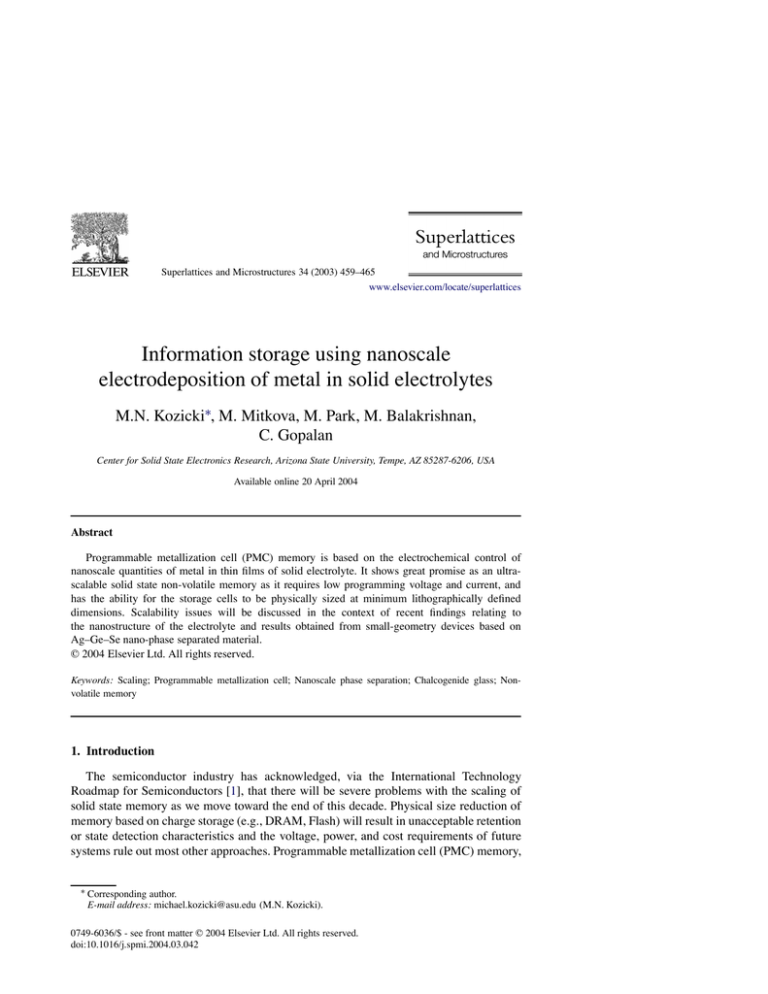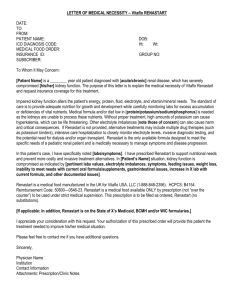
Superlattices and Microstructures 34 (2003) 459–465
www.elsevier.com/locate/superlattices
Information storage using nanoscale
electrodeposition of metal in solid electrolytes
M.N. Kozicki∗, M. Mitkova, M. Park, M. Balakrishnan,
C. Gopalan
Center for Solid State Electronics Research, Arizona State University, Tempe, AZ 85287-6206, USA
Available online 20 April 2004
Abstract
Programmable metallization cell (PMC) memory is based on the electrochemical control of
nanoscale quantities of metal in thin films of solid electrolyte. It shows great promise as an ultrascalable solid state non-volatile memory as it requires low programming voltage and current, and
has the ability for the storage cells to be physically sized at minimum lithographically defined
dimensions. Scalability issues will be discussed in the context of recent findings relating to
the nanostructure of the electrolyte and results obtained from small-geometry devices based on
Ag–Ge–Se nano-phase separated material.
© 2004 Elsevier Ltd. All rights reserved.
Keywords: Scaling; Programmable metallization cell; Nanoscale phase separation; Chalcogenide glass; Nonvolatile memory
1. Introduction
The semiconductor industry has acknowledged, via the International Technology
Roadmap for Semiconductors [1], that there will be severe problems with the scaling of
solid state memory as we move toward the end of this decade. Physical size reduction of
memory based on charge storage (e.g., DRAM, Flash) will result in unacceptable retention
or state detection characteristics and the voltage, power, and cost requirements of future
systems rule out most other approaches. Programmable metallization cell (PMC) memory,
∗ Corresponding author.
E-mail address: michael.kozicki@asu.edu (M.N. Kozicki).
0749-6036/$ - see front matter © 2004 Elsevier Ltd. All rights reserved.
doi:10.1016/j.spmi.2004.03.042
460
M.N. Kozicki et al. / Superlattices and Microstructures 34 (2003) 459–465
which is based on the electrochemical control of nanoscale quantities of metal in thin
films of solid electrolyte, shows great promise not only as an ultra-scalable but also as
a manufacturable solid state memory [2]. Key attributes are low internal voltage, low
power consumption, and the ability for the storage cells to be physically scaled to the
minimum possible area. Electrolyte formation is a relatively simple process, involving
the dissolution of silver in a chalcogenide or oxide glass. Standard processing equipment
may be utilized and no high-temperature steps are necessary. A silver-containing anode
and an inert cathode formed in contact with the electrolyte creates a device in which
information can be stored via electrical changes caused by the oxidation of the anode silver
and reduction of silver ions in the electrolyte. This occurs at an applied bias as low as
a few hundred mV and can result in a resistance change of many orders of magnitude
even for currents in the µA range. A reverse bias of the same magnitude will reverse
the process until the excess silver has been removed, thereby erasing the device. Since
information is retained via metal atom electro-deposition rather than charge storage, PMC
memory is non-volatile with excellent retention characteristics beyond 10 years [2]. Write
and erase can be achieved rapidly—both occur in the sub-20 ns regime—and endurance
appears to be good with no apparent degradation up to 1012 cycles. An operating window
with a wide temperature range is achievable and the cells may be formed using available
processing techniques in the metallization layers above the silicon devices in a back end of
line (BEOL) process.
This paper focuses on the scalability of the technology and presents some recent results
involving devices formed using electron beam lithography techniques. Size reduction
demands both physical and electrical scalability (low programming voltage and current)
and these issues will be discussed in the context of recent findings relating to the
nanostructure of the electrolyte.
2. Nanostructure of the solid electrolyte
The heart of the PMC memory cell (Fig. 1(a)) is the solid electrolyte and it is the
nanostructure of this material that is responsible for many of the operational characteristics.
We can form a solid electrolyte which will conduct ions over a wide range of operational
temperatures (e.g., −55 to +125 ◦C) by photodissolving silver from a metallic surface
source into a thin film of germanium chalcogenide glass until the resulting ternary is
chemically saturated with the metal [3]. Photodissolution is achieved using light energy
close to the optical gap of the starting glass (typically in the near UV). One acceptable
candidate for the hosting glass is Gex Se1−x , where x is usually close to 0.25. Silver uptake
ceases when all chemically available Se has reacted to form a separate phase close to
Ag2 Se. The amount of silver required for saturation depends on the composition of the
starting glass [3] but the resulting ternary can have silver incorporation in the tens of at.%.
The silver significantly modifies the transport properties of the material so that ion mobility
is relatively large, in the order of 10−4 to 10−3 cm2 /V s at room temperature, and the
availability of mobile silver throughout the electrolyte is high [4, 5]. Silver is also used as
the oxidizable metal in the anode of the PMC device and is particularly good in this respect
due to its nobility and the symmetry of oxidation and reduction characteristics [6], so that
it is readily added to and removed from the electrolyte.
M.N. Kozicki et al. / Superlattices and Microstructures 34 (2003) 459–465
461
Fig. 1. (a) Scanning electron microscope image of a PMC memory cell cross section fabricated using PMMA
as the dielectric. The Ag–Ge–Se electrolyte and silver anode are formed in a 100 nm via in the dielectric.
(b) Schematic of the nanostructure of the Ag–Ge–Se solid electrolyte. Electrolyte is nano-phase separated into
a dispersed conducting silver-rich phase and a germanium-rich/silver-poor resistive glassy interstitial phase. The
average size of the silver-rich phase is around 2 nm whereas the average interstitial gap is less than 1 nm.
We have recently established that the electrolyte formed by silver dissolution into a thin
film of chalcogen-rich glass is actually a nanostructured material [3, 7], consisting of a
finely dispersed low-resistivity silver-rich phase and an interstitial germanium-rich glassy
phase that exhibits high resistivity (Fig. 1(b)). In the case of the Ag–Ge–Se system, the
resistivity is around 2 m! cm for the silver-rich phase and is estimated to be as high
as 108 ! cm for the germanium-rich phase. For a silver-saturated ternary, the glassy
interstices between the silver-rich regions have an average width of less than 1 nm but
the material’s high resistivity makes the electrolyte resistance relatively high, in the order
of 102 ! cm for the selenide-based electrolyte. A “layered” electrolyte, in which the
silver concentration is less than 10 at.% within a few nm of the cathode, compared with
30–40 at.% in the rest of the film; can be created using the photodissolution process and
limiting the exposure time. This is useful in that it increases the off resistance of the
structure to as much as 1010 ! µm2 as the low-doped material has an effective resistivity
closer to that of the interstitial material [2, 4].
At the nanoscale, each silver-rich region in the current path acts as a local supply of
ions. For each excess ion that enters one of these regions from the anode side, one will
simultaneously leave on the cathode side and move into the interstitial zone there. Once
in this glassy material, the high local electric field will cause the ions to move toward the
adjacent downstream silver-rich region. The electron current from the cathode will also
flow into the electrolyte and the supply of both ions and electrons in the interstitial zones
results in electro-deposition so the excess metal in the electrolyte is effectively “stored”
in these regions. The nanoscale conductive electrodeposits bridge the interstitial regions
462
M.N. Kozicki et al. / Superlattices and Microstructures 34 (2003) 459–465
and help supply electrons to regions further away from the cathode until the bridging
to the anode is complete, thereby reducing the resistance between the electrodes. The
on characteristics of the PMC memory are determined by the “strength” of the electrodeposited links—the more reduced silver in the linking regions, the lower the effective
film resistance. However, the low resistivity of the silver-rich electrodeposits (less than
10−3 ! cm) mean that a nanoscale “link” in the order of a few tens of nm in diameter
will still result in an acceptable on resistance (less than 100 k!). The existence of this
nanoscale connection is confirmed by the fact that the off resistance is a function of device
geometry, whereas the on resistance is independent of device area. This insensitivity of
on resistance to device area has been established for devices ranging from 5 µm down to
100 nm in diameter [2].
The nanostructure of the electrolyte and the small diameter of the conducting pathway
formed by the electro-deposition process mean that the technology will indeed be
physically scalable.
3. Device characterization
Nanoscale PMC memory devices were fabricated using deep ultra violet (DUV)
lithography [2] and also by electron beam patterning of polymethylmethacrylate (PMMA)
dielectric. Since the latter is an atypical method, it is described in this section. Silicon
substrates with 100 nm thermally grown SiO2 were prepared and the bottom electrode was
defined using standard optical lithography. Approximately 100 nm of Ni was deposited
using an e-beam evaporator at ultra high vacuum (UHV) and lifted off to yield the
patterned bottom electrode. Electron beam lithography was carried out on this substrate
using 100 nm of spin-coated PMMA. A JEOL 6000 e-beam lithographic tool was used to
define the 100 × 100 nm vias aligned to the bottom electrode. After the via patterns were
developed, a layer of photoresist was spun on for the top electrode fabrication. The patterns
were transferred using standard optical lithography and after development, the photoresist
was completely exposed to ultraviolet radiation in order to facilitate a selective lift-off
process using the photoresist developer since the PMMA was soluble in acetone which is
traditionally used for lift-off. On this substrate, about 50 nm of Ge30 Se70 was evaporated
under UHV using a resistively heated Knudsen cell, immediately following this 25 nm of
Ag was evaporated without breaking the vacuum. This silver layer was incorporated in
the Ge30 Se70 glassy matrix by exposing it to UV radiation at 405 nm for about 30 min.
A top electrode layer of 25 nm Ag was then deposited using the evaporator. Finally,
the samples were treated with photoresist developer to selectively remove the previously
exposed photoresist yielding the device with PMMA itself as the dielectric.
Fig. 2 shows a typical switching (resistance–voltage) characteristic for a 100 nm
diameter PMC device with a 50 nm thick Ag0.33 Ge0.20 Se0.47 electrolyte. The sweep was
taken using a probe station connected to a semiconductor parameter analyzer (HP 4155C),
with a 10 µA current compliance. The off-resistance is around 2 × 108 !, which although
quite high, was lower than expected since larger devices typically with 1 µm via showed
an off resistance of greater than 1010 !. A cross-sectional electron microscopic analysis
revealed poor step coverage in the small pore. This caused the thinning of the film at the
M.N. Kozicki et al. / Superlattices and Microstructures 34 (2003) 459–465
463
Fig. 2. Resistance vs. voltage curve of a 100 nm diameter device fabricated using a 50 nm thick Ag-doped Ge–Se
solid electrolyte. Programming current was 10 µA and the write (switch on) and erase (switch off) thresholds
are +240 mV and −80 mV respectively. Off resistance is lower than expected due to poor step coverage in the
small-geometry via.
via edge which led to the overdoping of the chalcogenide film with silver, thereby reducing
the off resistance. The device switches to the on state of just less than 10 k!(Ron ) at
approximately +240 mV (the apparent rise in resistance with voltage following this is due
to the current compliance control) and returns to the high-resistance state (Roff ) at around
−80 mV. The high Roff to Ron ratio and the demonstrated low programming voltage and
current again are proof that the technology is a good candidate for further scaling.
In traversing an interstitial glass region, an ion moves less than 1 nm on average. For
an applied voltage of a few hundred mV across a film that is a few tens of nm thick, the
electric field in the interstitial regions will be around 105 V/cm. Since the high-field ion
mobility is as high as 10−3 cm2 /V s, the average ion transit time will be less than 1 ns.
Assuming that this is the limiting factor, the rapid ion supply will mean that each interstitial
region will have silver deposited in it in 1 ns or less. A write operation that results in a sub100 k! on resistance will involve multiple nanoscale storage volumes and a combination
of sequential and parallel electro-deposition will occur in these regions. Considering the
electrolyte nanostructure detailed above, around 20 serial interstitial 1 nm wide volumes
will be required in a 50 nm thick film (worst case) for anode to cathode bridging. These
will take 20 ns or less to fill assuming that they are filled in sequence. Several hundred
interstitial volumes will be involved in fully bridging the interstices in a 50 nm thick film
to produce an on resistance in the sub-100 k! range but since these will mostly lie in
parallel, a sub-20 ns bridging time is still attainable. The same reasoning can be applied in
the reverse bias case to predict a sub-20 ns erase time.
Fig. 3 gives an example of write–erase cycling of a typical PMC device. It was obtained
using a simple electrical measurement setup involving a function generator (AWG 2021),
digital storage oscilloscope (Tektronix TDS 540B), and a probe station. The characteristics
were dominated by the circuit parasitics at 2.3 MHz but device operation (write and erase)
is still clear. A ±1 V input signal was required to overcome the measurement system
impedance and the output signal, the voltage drop across a 90 k! series resistor, was noisy.
464
M.N. Kozicki et al. / Superlattices and Microstructures 34 (2003) 459–465
Fig. 3. Switching and cycling characteristic of a PMC memory cell. The output voltage is measured across a
90 k! series resistor. On and off switching is limited by the rise and fall time of the input signal. Input–output
time shift is due to a 2.8 pF parasitic capacitance.
Although the active device area is small, the high capacitance of the contact overlap implies
that the output signal would be time shifted. The apparent switching time (both write and
erase) is in the order of 35 ns but this is clearly limited by the rise and fall time of the input
signal and so it is not unreasonable to assume that the actual switching time is closer to
our prediction based on the nanostructural argument. To further confirm this, an arbitrary
waveform generator (Tektronix AWG 2021) was used along with the parameter analyzer
to create single pulses of 25 ns duration (the fastest the test set-up could reliably handle)
and it was observed that these were also sufficient to change the state of the device.
4. Conclusions
The prospects for the ultimate scalability of programmable metallization cell memory
technology are extremely good. First, the nanostructure of the electrolyte and the small size
of the conducting pathway are such that physical scalability well beyond current device
structures at 100 nm is thought possible. The low operational voltage and current (240 mV
and 10 µA for writing) will also promote scalability as the memory array interconnections
can be closely spaced and drive/select transistors can be at minimum geometry. In addition,
the speed of the devices means that the overall energy consumption will be extremely
low—less than 50 fJ—and this will not only mean low heat dissipation which is necessary
for small-geometry/high-density memory arrays but will also equate to longer battery life
in portable systems.
M.N. Kozicki et al. / Superlattices and Microstructures 34 (2003) 459–465
465
Acknowledgement
This work is supported by Axon Technologies Corporation.
References
[1] International Technology Roadmap for Semiconductors: Overall Roadmap Technology Characteristics,
Semiconductor Industry Association, San Jose, CA, 2002. Available from http://public.itrs.net/.
[2] R. Symanczyk, M. Balakrishnan, C. Gopalan, T. Happ, M. Kozicki, M. Kund, T. Mikolajick, M. Mitkova,
M. Park, C. Pinnow, J. Robertson, K. Ufert, Electrical characterization of solid state ionic memory elements,
in: Proceedings of the Non-Volatile Memory Technology Symposium, San Diego, CA, November, 2003.
[3] M.N. Kozicki, M. Mitkova, J. Zhu, M. Park, Nanoscale phase separation in Ag–Ge–Se glasses, Microelectron.
Engrg. 63 (1–3) (2002) 155–159.
[4] T. Kawaguchi, S. Maruno, S.R. Elliott, Optical, electrical, and structural properties of amorphous Ag–Ge–S
and Ag–Ge–Se films and comparison of photoinduced and thermally induced phenomena of both systems,
J. Appl. Phys. 79 (1996) 9096–9104.
[5] M. Ribes, E. Bychkov, A. Pradel, Ion transport in chalcogenide glasses: dynamics and structural studies,
J. Optoelectron. Adv. Mater. 3 (3) (2001) 665–674.
[6] K.H. Ng, H. Liu, R.M. Penner, Sub-nanometer silver clusters exhibiting unexpected metastability on graphite,
Langmuir 16 (2000) 4016–4023.
[7] M. Mitkova, M.N. Kozicki, Silver incorporation in Ge-Se glasses used in programmable metallization cell
devices, J. Non-Cryst. Solids 299–302 (2002) 1023–1027.




